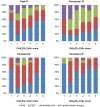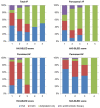Influence of atrial fibrillation subtypes on anticoagulant therapy in a high-risk older population: the FAI project
- PMID: 35543807
- PMCID: PMC9464178
- DOI: 10.1007/s40520-022-02140-w
Influence of atrial fibrillation subtypes on anticoagulant therapy in a high-risk older population: the FAI project
Abstract
Background and aim: Benefits of oral anticoagulants (OAC) in atrial fibrillation (AF) patients with moderate-to-high risk of stroke are independent of AF pattern. We evaluated whether AF clinical subtype influenced OAC use in a representative sample of the Italian older population.
Methods: A cross-sectional examination of all subjects aged 65 + years from three general practices in northern, central, and southern Italy started in 2016. A double-screening procedure was followed by clinical and ECG confirmation. Patients were categorized as having paroxysmal, persistent, or permanent AF. OAC use was evaluated in confirmed AF patients.
Results: The sample included 6016 subjects. Excluding 235 non-eligible, participation was 78.3%, which left 4528 participants (mean age 74.5 ± 6.8 years, 47.2% men). Overall, 319 AF cases were identified: 43.0% had paroxysmal, 21.3% persistent, and 35.7% permanent AF. Frequency of OAC therapy was 91.2% in permanent, 85.3% in persistent, and only 43.0% in paroxysmal AF (P < 0.001). In multivariate analysis, controlled for baseline variables and risk scales, persistent and permanent AF were associated with a significant increase in the likelihood of receiving OAC compared with paroxysmal AF (P < 0.001). This was confirmed for permanent AF also in multivariate analyses considering separately vitamin K antagonists or direct-acting oral anticoagulants (OR, 4.37, 95% CI, 2.43-7.85; and 1.92, 95% CI, 1.07-3.42, respectively) and for persistent AF and direct-acting oral anticoagulants (OR, 4.33, 95% CI, 2.30-8.15).
Conclusions: In a population-based survey, AF pattern was an independent predictor of OAC treatment. Paroxysmal AF is still perceived as carrying a lower risk of vascular events.
Keywords: Anticoagulants; Atrial fibrillation subtypes; Older population; Thromboembolism.
© 2022. The Author(s).
Conflict of interest statement
The authors declare that they have no conflict of interest to report for this article.
Figures
Similar articles
-
Anticoagulant and antiplatelet therapy for stroke prevention in atrial fibrillation patients in the clinical practice of a single district hospital in Poland.Kardiol Pol. 2013;71(12):1260-5. doi: 10.5603/KP.a2013.0179. Epub 2013 Aug 30. Kardiol Pol. 2013. PMID: 23990227
-
Incidence of stroke in paroxysmal versus sustained atrial fibrillation in patients taking oral anticoagulation or combined antiplatelet therapy: an ACTIVE W Substudy.J Am Coll Cardiol. 2007 Nov 27;50(22):2156-61. doi: 10.1016/j.jacc.2007.07.076. Epub 2007 Nov 13. J Am Coll Cardiol. 2007. PMID: 18036454 Clinical Trial.
-
Prevalence of Atrial Fibrillation Subtypes in Italy and Projections to 2060 for Italy and Europe.J Am Geriatr Soc. 2020 Nov;68(11):2534-2541. doi: 10.1111/jgs.16748. Epub 2020 Aug 12. J Am Geriatr Soc. 2020. PMID: 32786082
-
Oral anticoagulant therapy in atrial fibrillation patients at high stroke and bleeding risk.Prog Cardiovasc Dis. 2015 Sep-Oct;58(2):177-94. doi: 10.1016/j.pcad.2015.07.003. Epub 2015 Jul 7. Prog Cardiovasc Dis. 2015. PMID: 26162958 Review.
-
Meta-analysis of Stroke and Bleeding Risk in Patients with Various Atrial Fibrillation Patterns Receiving Oral Anticoagulants.Am J Cardiol. 2019 Mar 15;123(6):922-928. doi: 10.1016/j.amjcard.2018.11.055. Epub 2018 Dec 19. Am J Cardiol. 2019. PMID: 30691678 Review.
References
-
- Go AS, Hylek EM, Phillips KA, et al. Prevalence of diagnosed atrial fibrillation in adults: national implications for rhythm management and stroke prevention: the AnTicoagulation and Risk Factors in Atrial Fibrillation (ATRIA) Study. JAMA. 2001;285:2370–2375. doi: 10.1001/jama.285.18.2370. - DOI - PubMed
MeSH terms
Substances
Grants and funding
LinkOut - more resources
Full Text Sources
Medical



